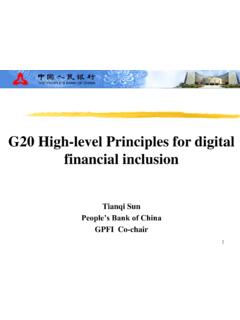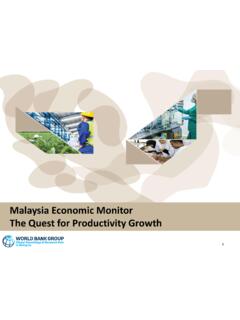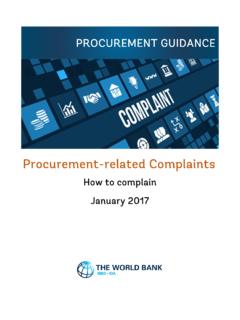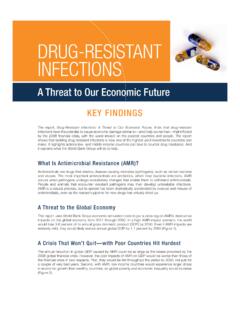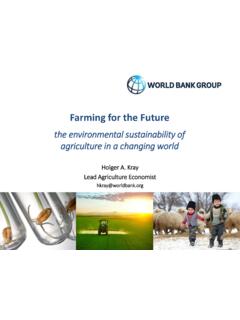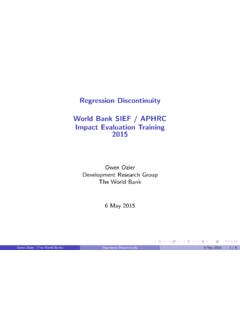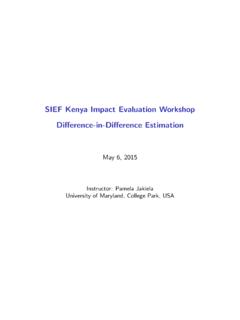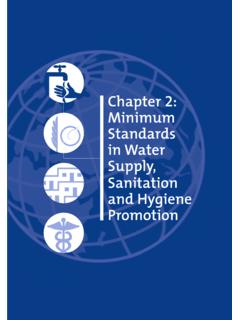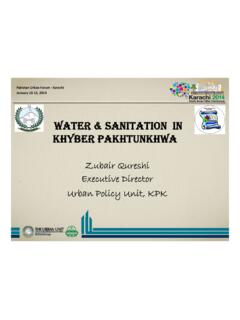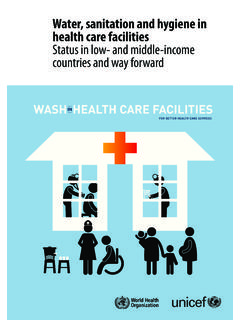Transcription of RESILIENT WATER SUPPLY AND SANITATION SERVICES
1 RESILIENT WATER SUPPLY AND SANITATION SERVICES THE CASE OF JAPANRESILIENT WATER SUPPLY AND SANITATION SERVICES THE CASE OF JAPAN 2018 The World BankInternational Bank for Reconstruction and Development The World Bank Group1818 H Street NW, Washington, DC 20433 USAF ebruary 2018 DISCLAIMERThis work is a product of the staff of The World Bank with external contributions. The findings, interpretations, and conclusions expressed in this work do not necessarily reflect the views of The World Bank, its Board of Executive Directors, or the governments they represent. The World Bank does not guarantee the accuracy of the data included in this work. The boundaries, colors, denominations, and other information shown on any map in this work do not imply any judgment on the part of The World Bank concerning the legal status of any territory or the endorsement or acceptance of such boundaries. Nothing herein shall constitute or be considered to be a limitation upon or waiver of the privileges and immunities of The World Bank, all of which are specifically reserved.
2 The report reflects information available up to November 30, AND PERMISSIONS The material in this work is subject to copyright. Because The World Bank encourages dissemination of its knowledge, this work may be reproduced, in whole or in part, for noncommercial purposes as long as full attribution to this work is given. Any queries on rights and licenses, including subsidiary rights, should be addressed to World Bank Publications, The World Bank Group, 1818 H Street NW, Washington, DC 20433, USA; e-mail: Cover image: Kyodo NewsUsed with permission. Further permission required for reuse. TABLE OF CONTENTSA cknowledgement iiiAbbreviations ivExecutive Summary v1 Introduction Background Objective of the Report Case Study Selection Organization of the Report 3 References 32 Legal and Institutional Frameworks of RESILIENT WATER SUPPLY and SANITATION SERVICES in Japan Overview Historical Development of WATER SUPPLY and SANITATION SERVICES in Japan 4 Overarching Legislations and Key Institution Systems Planning Engineering Design and Materials for Resilience Asset Management for RESILIENT WATER SUPPLY and SANITATION SERVICES Contingency Programming Contingency Funds for RESILIENT Recovery 20 References 213 Best Practices and Lessons Learned from Urban WATER SUPPLY and SANITATION Utilities in Japan Overview Fukuoka City: Building drought resilience and enhancing drainage capacity against urban floods Hiroshima City.
3 Enhancing WATER SUPPLY continuity against extreme rainfalls and landslides Kobe City: Enhancing resilience of WATER SUPPLY based on lessons learned from the 1995 Earthquake 47ii | Kumamoto City: Enabling rapid earthquake recovery through risk-informed investments Sendai City: Integrating business continuity and asset management after Great East Japan Earthquake Tokyo: Enhancing seismic resilience to ensure continuity of WSS SERVICES for 13 million residents 72 References 824 Recommendations for Policymakers and Utilities 87 Annex 1 List of Major Natural Disasters and their Impacts on WSS SERVICES since 1995 91 Annex 2 List of DRM and WSS Laws in Japan since 1949 93 | iiiACKNOWLEDGMENTS This report was written by a team led by Naho Shibuya and Roland Bradshaw of the World Bank. Primary and secondary research was mainly conducted by the Japan WATER Research Center (JWRC). The report benefited from additional research by Daijiro Mizutani of Tohoku University.
4 Special gratitude is extended to the Japanese WATER SUPPLY and SANITATION utilities that kindly provided primary data and inputs and shared their experience. These include the Fukuoka City Waterworks Bureau, Fukuoka City Road and Sewer Bureau, Hiroshima City Waterworks Bureau, Kobe City Waterworks Bureau, Kumamoto City Waterworks and Sewerage Bureau, Sendai City Waterworks Bureau, Sendai City Construction Bureau, Sendai City Crisis Management Department, Tokyo Metropolitan Government Bureau of Waterworks, and Tokyo Metropolitan Government Bureau of Sewerage. The report benefited from the peer reviews and guidance of the following Japanese experts: Takenobu Nagahira, deputy director, WATER SUPPLY Division, Ministry of Health, Labour and Welfare; Makoto Matsubara, director for sewerage planning coordination, Sewerage Planning Division, Ministry of Land, Infrastructure, Transport and Tourism; Tatsuo Omura, professor, Tohoku University (New Industry Creation Hatchery); Satoshi Takizawa, professor, Department of Urban Engineering, Graduate School of Engineering, University of Tokyo; and Yasunori Kimura, adviser for Kanto Region, Japan Ductile Iron Pipe Association.
5 Also, the team extends special thanks to Kiyoshi Kobayashi, director, Management Research Center, Graduate School of Management, Kyoto University as well as Kiyoyuki Kaito, professor, Department of Civil Engineering, Graduate School of Engineering, Osaka University. The team acknowledges the valuable contributions from World Bank peer reviewers, including Shoko Takemoto, Satoru Ueda, and Gerhardus Nicolaas Albertus Soppe. The team is also grateful for the support from Luis Tineo, Francis Ghesquiere, Maria Angelica Sotomayor, Guillermo Siercke, and Marc report greatly benefited from the professional editorial SERVICES of Mary A. Anderson; graphic design by Interbooks Co., Ltd and Carlos Plaza Design Studio; and project support from Haruko Nakamatsu, Yukiko Furuichi, Vibhu Jain, and Mayumi Asakura. This report was prepared with support from the Japan - World Bank Program for Mainstreaming Disaster Risk Management in Developing Countries.
6 Iv | ABBREVIATIONS AM asset managementBCM business continuity managementBCP business continuity planDRM disaster risk managementEPC engineering, procurement, and constructionFRSB Fukuoka City Road and Sewerage BureauFWB Fukuoka City Waterworks BureauGEJE Great East Japan Earthquake GIS geographic information systemHCWB Hiroshima City Waterworks BureauJSWA Japan Sewage Works AssociationJWWA Japan WATER Works AssociationKCWB Kobe City Waterworks BureauKWSB Kumamoto City Waterworks and Sewerage BureauLMICs low- and middle-income countriesMHLW Ministry of Health, Labour and WelfareMLIT Ministry of Land, Infrastructure, Transport and TourismMoU memorandum of understandingO&M operation and maintenanceSCB Sendai City Construction BureauSWB Sendai City Waterworks BureauTEC-FORCE Technical Emergency Control ForceTMBS Tokyo Metropolitan Government Bureau of SewerageTMBW Tokyo Metropolitan Government Bureau of WaterworksUPS uninterruptible power supplyWSS WATER SUPPLY and sanitationWTP WATER treatment plantWwTP wastewater treatment plantEXECUTIVE SUMMARY | vEXECUTIVE SUMMARY Japan has built the resilience of its WATER SUPPLY and SANITATION (WSS) SERVICES through an adaptive management approach based on lessons learned from past natural disasters.
7 This experience offers key insights for low- and middle-income countries (LMICs) seeking to sustain and build resilience of WSS SERVICES . Sustainability of Essential WSS SERVICES at RiskNatural disasters have increasingly damaged WSS facilities and infrastructure, leaving entire communities without safe and reliable drinking WATER and the appropriate disposal of wastewater. These emergency events could arise from inundation of facilities, loss of electricity, and exposure and disruption of infrastructures. Less-severe impacts can arise from increased siltation of reservoirs and slow-onset events such as droughts, thus having longer-term effects on the resilience and reliability of SERVICES . These WSS service failures or interruptions could set off a cascading effect across interconnected infrastructure systems including public health and fire SERVICES , which in turn could pose both direct and indirect economic example, recent natural disasters that affected the utilities in Japan include the following: In 1978 and 1994, Fukuoka City experienced severe droughts that necessitated WATER rationing for approximately 300 days each.
8 The 1995 Hanshin-Awaji Earthquake (magnitude ) took the lives of 4,571 people and severely damaged the infrastructure; it took 10 weeks to restore piped WATER SUPPLY . The 2011 Great East Japan Earthquake (GEJE) of magnitude led to a loss of WATER access among up to 500,000 residents in Sendai City, and the city s primary wastewater treatment plant was completely submerged by tsunami. The GEJE had a seismic intensity at the upper-5 level in Tokyo, and led to a temporary service disruption to 42,000 residents. 12 kilometers of sewerage pipelines were adversely affected by cracks and sand clogging owing to earthquake-induced soil liquefaction. Multiple precipitation-induced landslides in 2014 in Hiroshima City extensively damaged the WATER distribution networks and other facilities, causing approximately 3,500 households to lose access to WATER . In 2016, two earthquakes of magnitudes and caused all residents in Kumamoto City (up to 326,000 households) to lose access to more investment is urgently needed to improve basic WATER and SANITATION access in LMICs, maintaining or enhancing the disaster resilience of both new and existing (particularly aging) infrastructure especially in the context of climate change and variability is also critical for sustainable | RESILIENT WATER SUPPLY AND SANITATION SERVICESL egal and Institutional Frameworks for RESILIENT WSS SERVICES in Japan As chapter 2 discusses, rapid urbanization and population growth during the 1960s 80s as well as a cholera outbreak led Japan to rapidly develop WATER resources and wastewater SERVICES under the 1957 Waterworks Act and 1958 Sewerage Act.
9 The WATER SUPPLY coverage has increased from 26 percent in 1950 to 98 percent in 2015, while wastewater SERVICES have increased from 6 percent in 1961 to 90 percent in 2016. WSS SERVICES are delegated from the Ministry of Health, Labour and Welfare (for WATER SUPPLY ) and from the Ministry of Land, Infrastructure, Transport and Tourism (for sewerage) to the on the 1961 Disaster Countermeasures Basic Act, WSS utilities develop and implement disaster risk management (DRM) planning and measures, which are iteratively improved based on lessons learned from past natural disasters (figure ). As a guide to design, construct, and operate WSS systems in accordance with the laws, the Japan WATER Works Association and the Japan Sewage Works Association develop guidelines and establish a mutual support network of member utilities in case of disasters. Figure Development of Disaster Management Plans at National and Local LevelsDisaster Countermeasures Basic ActBasic Disaster Management PlanNational plan based on the results of disaster risk assessmentPrefecture Disaster Management PlanCity Disaster Management PlanRegional plans based on the results of disaster risk assessmentWater SUPPLY & SANITATION (WSS) Disaster Management PlanUtility plans for WSS systems based on upper-level plansDesign and ConstructionEmergency Preparedness and Response PlanAsset Management SystemBusiness Continuity PlanOperation & Maintenanceplans and manualsNational LevelPrefecture and City LevelUtility LevelGiven the aging infrastructure and limited financial resources, the utilities have improved asset management practices to extend the lifetime of assets and to enhance system resilience.
10 To incentivize utilities to develop or upgrade the WSS facilities that are critical for building RESILIENT and inclusive communities, the Japanese central government prepares contingency funds and provides a range of subsidy programs. EXECUTIVE SUMMARY | viiUrban WSS Utility Best Practices and Lessons LearnedUtilities in Japan offer insightful lessons based on their accumulated experience of natural disasters, which include earthquakes, landslides, cyclones, floods, drought, and tsunamis (chapter 3). Map shows the location of utilities and the types of natural hazards addressed in the report. Map Case Study WSS Utilities, SERVICES Covered, and Natural Hazards Faced EarthquakeTOKYO METROPOLISI ntense rainLandslideHIROSHIMA CITYE arthquakeKUMAMOTO CITYE arthquakeKOBE CITYE arthquakeTsunami WATER SUPPLY SANITATION WATER SUPPLY WATER SUPPLY SANITATION WATER SUPPLY SANITATION WATER SUPPLY WATER SUPPLY SanitationSENDAI CITYD rought InundationsFUKUOKA CITYS ource: World Bank.

